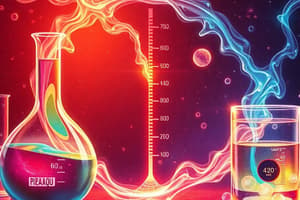Podcast
Questions and Answers
What defines the basicity of an acid?
What defines the basicity of an acid?
The basicity of an acid is defined as the number of hydrogen ions that can be produced per molecule of the acid in an aqueous solution.
Give an example of a dibasic acid and explain its basicity.
Give an example of a dibasic acid and explain its basicity.
An example of a dibasic acid is H2SO4, which has a basicity of 2 because it produces two hydrogen ions per molecule.
What is the basicity of H3PO4 and how does it behave in solution?
What is the basicity of H3PO4 and how does it behave in solution?
H3PO4 has a basicity of 3; it ionizes to produce three hydrogen ions per molecule in a solution.
Describe a monobasic base and provide an example.
Describe a monobasic base and provide an example.
What characterizes a triacidic base, and can you name one?
What characterizes a triacidic base, and can you name one?
How does the basicity of an acid relate to the number of replaceable hydrogen ions?
How does the basicity of an acid relate to the number of replaceable hydrogen ions?
What is the acidity of a diacidic base, and what does it imply?
What is the acidity of a diacidic base, and what does it imply?
Can you name a monobasic acid and its characteristic behavior in solution?
Can you name a monobasic acid and its characteristic behavior in solution?
Explain the concept of dissociation in dibasic acids using an example.
Explain the concept of dissociation in dibasic acids using an example.
What types of salts can tribasic acids form and why?
What types of salts can tribasic acids form and why?
Flashcards are hidden until you start studying
Study Notes
Basicity of Acids & Acidity of Bases
- Basicity of an acid: Number of hydrogen ions generated per molecule in aqueous solution.
- Acidity of a base: Number of hydroxyl ions produced per molecule in aqueous solution.
Monobasic Acid
- Basicity: 1; produces one hydrogen ion per molecule.
- Contains one replaceable hydrogen ion if water-soluble.
- Dissociates in one step in aqueous solution.
- Examples include HCl, HNO3, and CH3COOH.
- Acetic acid (CH3COOH) has four hydrogen atoms but only releases one ion.
Dibasic Acid
- Basicity: 2; produces two hydrogen ions per molecule.
- Contains two replaceable hydrogen ions in water-soluble acids.
- Dissociates in two steps in aqueous solution.
- Examples include H2SO3, H2SO4, and H2CO3.
Tribasic Acid
- Basicity: 3; produces three hydrogen ions per molecule.
- Contains three replaceable hydrogen ions if water-soluble.
- Dissociates in three steps in aqueous solution.
- Example: H3PO4.
- Can form three salts:
- NaH2PO4 (monosodium dihydrogen phosphate)
- Na2HPO4 (disodium hydrogen phosphate)
- Na3PO4 (trisodium phosphate - normal salt)
Monoacidic Base
- Acidity: 1; produces one hydroxyl ion per molecule.
- Contains one replaceable hydroxyl ion if water-soluble.
- Dissociates in one step in aqueous solution.
- Examples: NaOH, KOH, NH4OH.
Diacidic Base
- Acidity: 2; produces two hydroxyl ions per molecule.
- Contains two replaceable hydroxyl ions in water-soluble bases.
- Dissociates in one step in aqueous solution.
- Examples: Ca(OH)2, Zn(OH)2, Cu(OH)2.
Triacidic Base
- Acidity: 3; produces three hydroxyl ions per molecule.
- Contains three replaceable hydroxyl ions if soluble.
- Dissociates in one step in aqueous solution.
- Example: Al(OH)3, Fe(OH)3 (note: water insoluble).
Studying That Suits You
Use AI to generate personalized quizzes and flashcards to suit your learning preferences.




